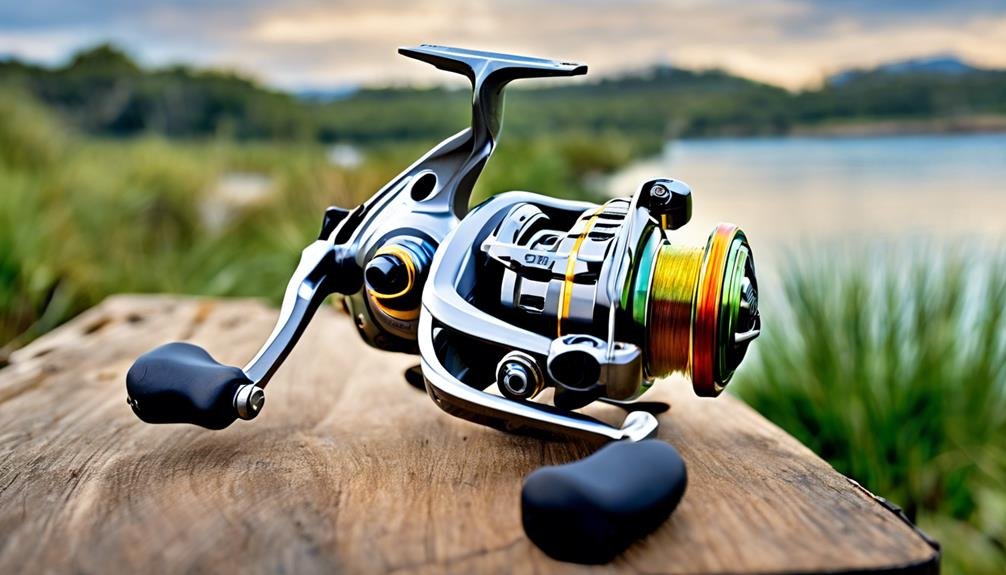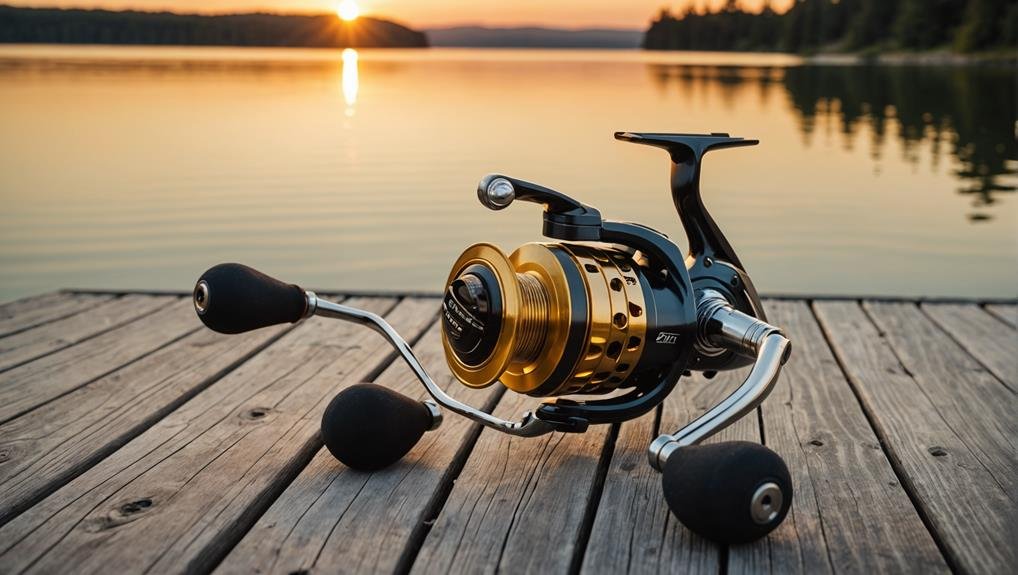If you want to elevate your fishing experience, a bait caster reel might be the tool you need. Unlike other reels, bait casters offer unmatched precision and control, allowing you to target specific spots easily easily easily easily. However, mastering a baitcasting reel requires some skill and patience. You’ll understand the nuances of adjusting the brakes and tension to avoid backlash. But once you get the hang of it, you’llyou’llciate the increased casting distance and power. Are you curious about how bait casters stack up against spinning reels or the pros and cons? Let’s look at these aspects next.
Key Takeaways
- Baitcasting reels offer superior accuracy and control for targeting specific fishing spots.
- Its power and robust drag systems are ideal for heavy lures and larger fish.
- They are equipped with braking systems to prevent backlash, ensuring smoother casts.
- It requires a learning curve but provides greater casting distances and line control.
- Generally, it is more expensive and requires regular maintenance for optimal performance.
Types of Fishing Reels

When planning a fishing trip, understanding the different types of fishing reels can significantly impact your success. The reel you choose greatly affects your casting distance and accuracy, which are vital for a good catch.
Baitcasting Reels are renowned for their ability to deliver greater accuracy and longer casting distances. Thanks to their revolving perpendicular spool design, these reels are ideal for using heavier lures and targeting larger fish species.
On the other hand, spinning reels have a fixed, parallel spool and are typically favored for their ease of use, especially by beginners. They’re also suitable for lighter lures and can handle various fishing techniques. Each type of fishing reel offers unique advantages and is selected based on your personal preference, fishing style, and the species you’re targeting.
Electric and ice fishing reels are specialized options for specific conditions and techniques. Electric reels are great for deep-sea fishing, offering power and convenience, while ice fishing reels are built to withstand frigid temperatures and unique fishing environments. By understanding these differences, you’ll be better equipped to choose the right reel for your next adventure.
Features of Casting Reels
Casting reels, often prized for their exceptional accuracy and distance, are designed to help you precisely precisely target specific areas. When you’re, you’re a Baitcasting Reel, you’re supposed to handle heavier lures and larger fish, giving you the power and control you need during retrieval. Unlike spinning reels, these require more skill and practice, but the payoff is worth it.
One of the standout features is the braking system. This component is essential for preventing backlash, ensuring smoother and more accurate casts. Whether you choose a low-profile baitcasting reel for its comfortable grip or a traditional round reel, the braking system will be your best friend in achieving those precise casts.
Here is a look at what makes casting reels so special:
| Feature | Benefit |
|---|---|
| Accuracy | Target specific areas precisely |
| Power | Handle larger fish easily |
| Braking System | Prevents backlash |
| Control | Better handling of heavy lures |
| Low Profile Baitcasting | Comfortable and ergonomic |
With these features, casting reels offer unmatched accuracy, power, and control. They might take some time to master, but you are for any serious angler once you do.
Using a Baitcasting Reel

Have you ever wondered how to get the most out of your baitcasting reel? Start by familiarizing yourself with its components. The spool, brake system, and drag adjustments are key to effective casting and retrieval. Practice spooling your reel with the fishing line correctly; this guarantees smooth casting and minimizes tangles.
Next, you’ll need to make some adjustments. The brake system and drag settings should be tailored to your lure and fishing conditions. Don’t Make these adjustments—they can significantly impact your casting performance.
When you’re, you’re to cast, hold the rod, and reel properly with one hand, maintaining a firm grip. This gives you better control and helps prevent backlash.
Practice makes perfect, so take your baitcasting reel to an open area and work on your casting technique. Focus on accuracy and distance. The more you practice, the more proficient you will become.
Spinning Vs. Casting Reels
Choosing between spinning and casting reels can greatly impact your fishing experience. Spinning reels feature a fixed, parallel spool design, making them user-friendly and ideal for beginners. Their simple mechanics allow you to cast lighter lures and perform finesse fishing easily.
On the other hand, casting reels, often called baitcasting reels, have a revolving perpendicular spool. This design provides more accuracy and power, making them perfect for experienced anglers aiming for larger fish and heavier lures.
Your choice between these reels depends on your preference, fishing style, and target species. A spinning reel might be more suitable for beginners due to its straightforward operation. Spinning reels excel in situations where light lures and precision matter.
However, casting reels offer the precision you need if you are an experienced angler looking for control and advanced techniques.
Both reels have their strengths. Spinning reels are easier to use and manage while casting reels to provide precise control, which is essential for more advanced fishing techniques. Ultimately, your decision should be based on your skill level and the type of fishing you plan to pursue.
Pros and Cons of baitcasters

Baitcasters have distinct advantages and disadvantages that can greatly influence your fishing experience. When you use a baitcasting reel, you’ll enjoy several benefits, such as superior accuracy and enhanced casting distance; these reels offer excellent line control, making them ideal for targeting larger fish species and using heavier lines due to their power and drag control. However, mastering a bait cast reel demands practice and skill.
Here are the pros and cons of using a bait caster:
- Pros:
- Accuracy: Baitcasters allow for precise casting, which is essential when targeting specific spots.
- Casting Distance: You have longer casting distances, vital for covering more water.
- Line Control: Enhanced line control helps you easily manage heavier lines and lures.
- Power and Drag: These reels offer superior power and drag control, perfect for battling larger fish.
- Cons:
- Learning Curve: Mastering the bait cast reel takes time and practice.
- Backlash: Improper adjustment of the tension knob can lead to backlash, though this can be minimized with practice.
- Cost: Baitcasters tend to be more expensive than spinning reels.
- Maintenance: They require more maintenance to keep them functioning smoothly.
Understanding these pros and cons will help you decide if a bait caster fits your angling needs.
Conclusion
You’ve got a solid grasp on bait casters and how they can elevate your fishing experience. Don’t be Intimidated by the learning curve; with practice, you’ll master the casting technique and enjoy the benefits of increased distance, line control, and power. Whether you’re switching from spinning reels to casting reels or weighing the pros and cons, remember that a bait caster can be a game-changer for serious anglers like you. So, gear up and cast with confidence!
FAQs
What is a baitcaster reel, and how does it work?
A bait caster reel is a fishing reel mounted on the rod. Unlike spinning reels, where the line is pulled off a fixed spool, bait casters have a rotating spool that turns as the line is cast. This design gives anglers greater control over the placement of their lure, making it ideal for targeting specific areas or catching larger fish.
How It Works:
- Rotating Spool: The spool spins when casting, allowing the angler to control the line.
- Precision Casting: Baitcasters provide better accuracy and control for experienced anglers.
- Thumb Control: Anglers use their thumb to control the spool, preventing backlash (line tangles) when casting.
What are the advantages of using a baitcaster reel?
Baitcaster reels offer several advantages, particularly for experienced anglers:
- Precision and Control: Baitcasters provide excellent casting control, allowing you to place your lure exactly where you want it.
- Heavier Lures: Baitcasters are well-suited for casting heavier lures and baits, making them ideal for catching larger fish like bass, pike, or catfish.
- Durability: Baitcaster reels are designed for strength and durability, handling heavy lines and big fish.
- Longer Casting Distance: With proper technique, bait caster reels allow longer, smoother casts than spinning reels.
Advantages:
- Precision: Great accuracy for targeted casting.
- Heavier Lures: Ideal for larger baits and fish.
- Durability: Built for strength and long-term use.
- Long Casting: Enables long-distance casting with smooth control.
How do you prevent backlash on a baitcaster reel?
Backlash, also known as a “bird'”bird’s” occur,” occurs when the spool spins faster than the line can leave the reel, resulting in tangles. To prevent backlash, follow these tips:
- Adjust the Brakes: Modern bait casters have adjustable brakes. Start with a higher brake setting, which slows down the spool, reducing the risk of backlash.
- Tension Knob: Adjust the spool tension knob based on the weight of your lure. A properly adjusted tension knob will allow the lure to fall slowly when you release the line.
- Thumb Control: Use your thumb to control the spool during the cast, applying light pressure to slow the spool as the lure hits the water.
- Practice Casting: Backlash is more common with beginners, so practicing short, controlled casts can help you improve your technique over time.
Preventing Backlash:
- Brakes: Adjust the reel’s reel settings for more control.
- Tension Knob: Match the tension to your lure’slure’st.
- Thumb Control: Use your thumb to slow the spool during casting.
- Practice: Focus on short, controlled casts to improve technique.
When should you use a baitcaster reel?
A baitcaster reel is best used in situations that require precision and control. These reels are great for:
- Heavy Lures and Baits: When fishing with heavy lures like jigs, crankbaits, or swimbaits, bait casters provide the power and control needed.
- Targeted Casting: For fishing in tight spaces like under docks or near structures, bait casters allow for pinpoint accuracy.
- Bass Fishing: Baitcasters are a favorite among bass anglers because they can handle heavy lines and large lures, often needed to catch big bass.
- Larger Fish: Baitcasters are ideal for catching larger species that require stronger lines and greater drag capacity.
Best Use Cases:
- Heavy Lures: Ideal for large, heavy baits.
- Precision Casting: Best for accurate, controlled casts near structures.
- Bass Fishing: Excellent for targeting large fish.
- Larger Species: Suitable for fishing strong, heavy species.
How do you properly set up a baitcaster reel?
Setting up a bait caster reel correctly can improve your casting experience and prevent common issues like backlash. Here set it up:
- Spool the Line: Begin by spooling your line onto the reel, threading it through all the rod guides before tying it onto the reel’sreels.
- Adjust the Brakes: If you are a beginner, set the braking system to the highest setting or adjust it to your preference for more control.
- Set the Tension Knob: Hold your rod at a 45-degree angle and release the spool. Adjust the tension knob so that the lure drops slowly to the ground when the spool is released.
- Fine-Tune: Once the brakes and tension are set, you can fine-tune them during your fishing trip based on the conditions, such as wind or lure weight.
Setup Steps:
- Spool the Line: Thread the line and spool it evenly.
- Adjust Brakes: Set brakes to reduce backlash risk.
- Tension Knob: Match the tension to the weight of your lure.
- Fine-tune: Make adjustments based on fishing conditions.

